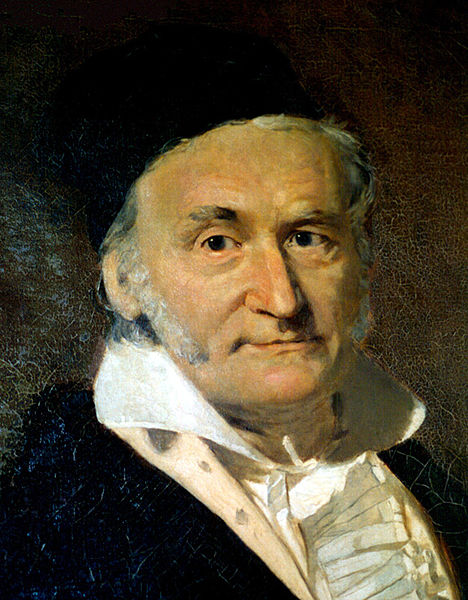2.1. Spotlight: Carl Friedrich Gauss¶
2.1.1. Spotlight: Carl Friedrich Gauss¶
He lives everywhere in mathematics.
—E.T. Bell, Men of Mathematics
Carl Friedrich Gauss is considered by many the greatest mathematician who ever lived. He was born in Brunswick, Germany on April 30, 1777. Gauss was a child prodigy, who was reported as able to perform long computations in his head. At age 10 he studied algebra and analysis. He made his first fundamental discoveries while still a teenager. Among these was the least squares method for handling statistical data and a proof that a regular 17-sided polygon can be constructed with only a straightedge and a compass. This was the first result of its kind since discoveries by the Greeks 2,000 years earlier.
He completed his monumental book on number theory, Disquisitiones Arithmeticae in 1798 at the age of 21 [Gauss65]. It summarized previous work in a systematic way and introducing many fundamental ideas of his own.
In 1801, the same year Disquisitiones Arithmeticae was published, the asteroid Ceres was observed by astronomers. Unfortunately, they could only make observations across 3 degrees of the sky before it was obscured by the sun. Several months later, when Ceres should have reappeared, Piazzi could not locate it: the mathematical tools of the time were not able to extrapolate a position from such a scant amount of data—three degrees represent less than 1% of the total orbit. In what seemed a superhuman feat at the time, Gauss used the available data to calculate the orbit of Ceres. As part of his work, he showed that experimental data varies within a bell-shaped curve, now called the Gaussian distribution. This achievement established his reputation as a genius before the age of 25.
Gauss also developed tables of logarithms now known as Gaussian logarithms.
Gaussian logarithms are designed to facilitate finding the common logarithm of a sum or difference of two numbers whose common logarithms are known. The object of a table of Gaussian logarithms, sometimes known as Addition and Subtraction Logarithms, is to give log(a±b) by single entry when loga and logb are known.
When Gauss died, many unpublished notes and manuscripts were found in his desk. When his complete Collected Works were finally published later, it had taken a group of scientists nearly seventy years to review and edit his writings.
Today Gauss's name occurs in many places in mathematics and science:
- The normal probability distribution as also called the Gaussian curve or distribution
- Gauss's Laws for Gravity and Electrostatics
- The hypergeometric series, a.k.a the Gaussian series
- Gaussian equations in spherical trigonometry
- Gaussian curvature in differential geometry
- Gaussian optics and Gaussian beams describing electromagnetic radiation
Gauss died in Göttingen, at the age of 78 on February 23, 1855. In Brunswick, there is a statue of him. Its base is, appropriately, a 17 pointed star.
| [1] | Gottlieb Biermann, Portrait of Carl Friedrich Gauss By Gottlieb Biermann A. Wittmann (photo) [Public domain], via Wikimedia Commons |



